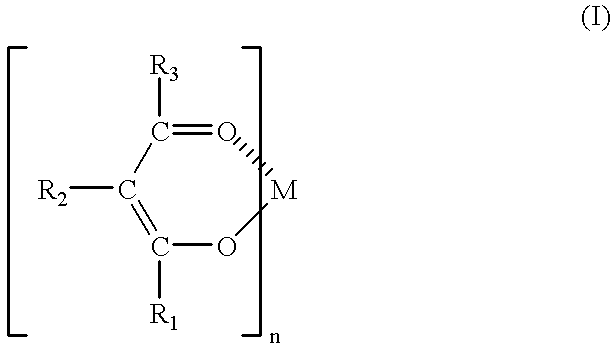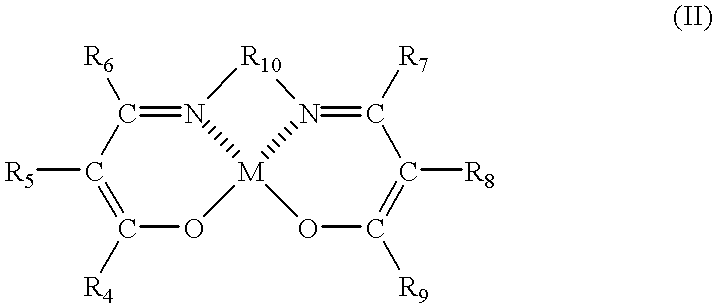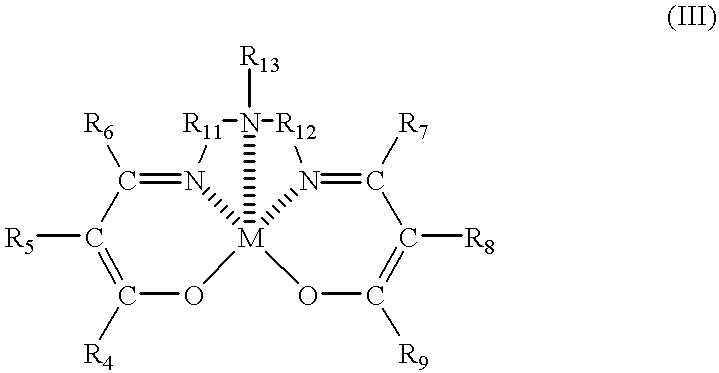Resin composition and process for producing the same
- Summary
- Abstract
- Description
- Claims
- Application Information
AI Technical Summary
Benefits of technology
Problems solved by technology
Method used
Image
Examples
example 1
A stirrer, 1.5 g of cashew nut shell liquid, 10 ml of 1,4-dioxane, and 8 mg of Fe (salen) were introduced into a 100 ml eggplant-type flask, and stirred by a magnetic stirrer. This flask was placed in an oil bath at 30.degree. C. 57 .mu.l of 30% aqueous hydrogen peroxide was added thereto 10 times at 6-minutes intervals with stirring. After addition, stirring was continued for 1 hour at 30.degree. C., to allow the reaction to proceed. After the reaction was finished, an aliquot of the reaction solution was analyzed by GPC. The Conv. was 42%, the Mn was 3500, and the Mw / Mn was 1.70. Precipitates obtained by introducing a part of the reaction solution into a large amount of methanol were recovered by centrifugation, and were dried under reduced pressure. According to the proton NMR analysis of this product, it was confirmed that about 80% of olefin site in the side chain of the cashew nut shell liquid remain.
example 2
A stirrer, 1.5 g of cashew nut shell liquid, 10 ml of toluene, and 16.1 mg of Fe (salen) were introduced into a 100 ml eggplant-type flask, and stirred by a magnetic stirrer. This flask was placed in an oil bath at 40.degree. C. 107 .mu.l of 30% aqueous hydrogen peroxide was added thereto 5 times at 15-minutes intervals with stirring. After addition, stirring was continued for 45 minutes at 40.degree. C., to allow the reaction to proceed. After the reaction was finished, an aliquot of the reaction solution was analyzed by GPC. The Conv. was 87%, the Mn was 5600, and the Mw / Mn was 1.83. Precipitates obtained by introducing a part of the reaction solution into a large amount of methanol were recovered by centrifugation, and were dried under reduced pressure. According to the proton NMR analysis of this product, it was confirmed that 75% of olefin site in the side chain of the cashew nut shell liquid remain.
example 3
The same procedure as in Example 1 was carried out except that 100 .mu.l of pyridine was added. The Conv. was 55%, the Mn was 4100, and the Mw / Mn was 1.86.
PUM
| Property | Measurement | Unit |
|---|---|---|
| Fraction | aaaaa | aaaaa |
| Fraction | aaaaa | aaaaa |
| Fraction | aaaaa | aaaaa |
Abstract
Description
Claims
Application Information
 Login to View More
Login to View More - R&D
- Intellectual Property
- Life Sciences
- Materials
- Tech Scout
- Unparalleled Data Quality
- Higher Quality Content
- 60% Fewer Hallucinations
Browse by: Latest US Patents, China's latest patents, Technical Efficacy Thesaurus, Application Domain, Technology Topic, Popular Technical Reports.
© 2025 PatSnap. All rights reserved.Legal|Privacy policy|Modern Slavery Act Transparency Statement|Sitemap|About US| Contact US: help@patsnap.com



